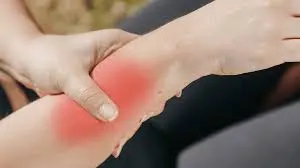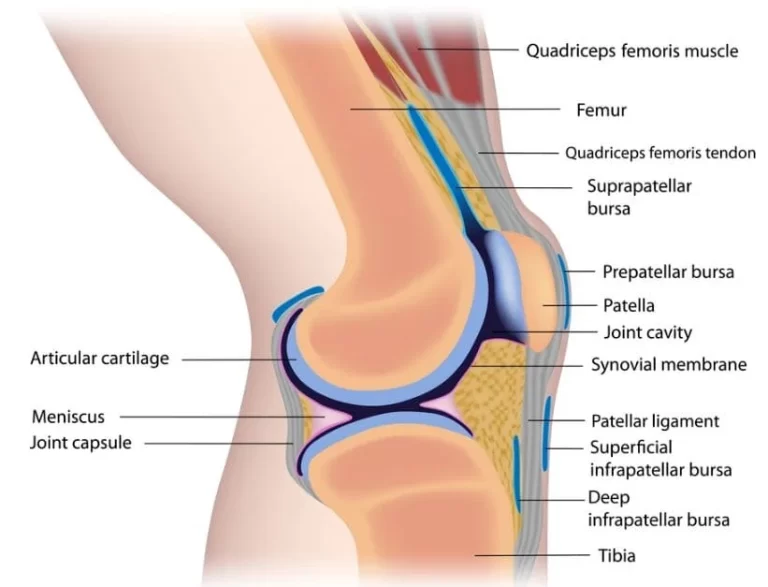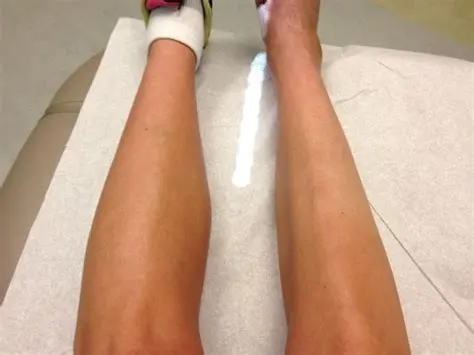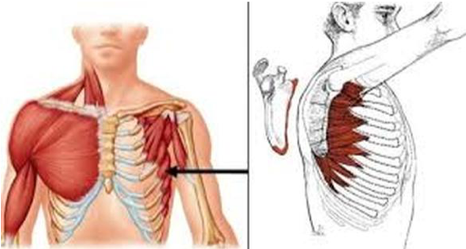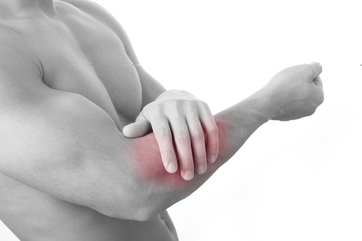Forearm Pain
Table of Contents
What is a Forearm Pain?
Forearm pain is a common complaint that can occur due to a variety of reasons, including injury, overuse, or underlying medical conditions. The forearm is a complex structure consisting of bones, muscles, tendons, and nerves that work together to facilitate movement of the hand and arm. Pain in the forearm can be a symptom of a minor injury or a sign of a more serious condition that requires medical attention.
Introduction:
The forearm consists of two bones named:
The Radius and the Ulna
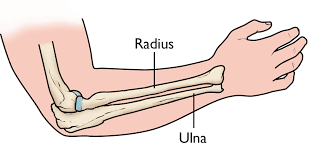
The ulna and radius are the two bones that form the forearm and join at the wrist. Furthermore, in the forearm, there are several muscles, tendons, ligaments, soft tissues, and other supporting structures in the forearm. Forearm pain can result from damage or disease to any of these structures.
The forearm is assembled up of two long bones: the radius (thumb side) and the ulna, which come jointly to make the proximal (elbow) and distal radioulnar joint (wrist).
The main activity of the forearm is rotation and this permits a movement known as supination (turning palms in an upward direction) and pronation (turning palms in a downward direction). This is a crucial move as it allows us to twist a doorknob or use a screwdriver.
Muscles:
The muscles in the forearm permit the movements of supination and pronation. Multiple muscles that allow for the gripping of the hand and movement of the wrist and fingers all arise in the forearm.
The muscles in the forearm can be divided into two groups:
- Flexors: Flexors muscles are situated on the front side of the forearm (palm side) which help in turning the forearm palms facing down, as well as flexing the wrist and hand downward into flexion.
- Extensors: Extensors are situated on the back of the forearm which helps in turning the forearm palms facing upwards, as well as extending the wrist and hand backward into an extended position.
With all the weighty use the forearm gets during daily activities, it is no surprise it can get sore! Below are some of the most ordinary injuries of the forearm:
- Elbow pain: Elbow pain consists of two types:
Tennis elbow or lateral epicondylitis
Golfers elbow or medial epicondylitis - Tenosynovitis: Synovial sheath that protects the tendon in the forearm. Inflammation due to the tendon injury or sudden use of the tendon.
The forearm is required for many arm and hand movements. The pain in this area can make life very difficult. For instance, forearm pain can make it challenging for an individual to hold a thing with the hand, work on a PC console, or bring up a kid. In most cases, a person can manage their forearm pain with conservative treatment, including rehab exercises.
What is Forearm pain?
Forearm pain (aka tennis elbow or lateral epicondylitis) encloses any form of discomfort or pain sensed in the arm between the wrist and the elbow. Any of the tissues in the forearm, including the muscles, bones, tendons, and skin, can experience forearm pain as a result of an injury or inflammation. Forearm discomfort may hit anybody and is often the result of a traumatic or repeated usage injury.
The reasons for lower arm pain normally incorporate sport wound, abuse wounds, cracks, squeezed nerves, or accidents. A general infection that causes body aches, like a cold, or an infection of the forearm’s tissues can also cause forearm pain. In a couple of cases, forearm pain might be connected with a harmless development, like a growth, or even threatening cancer.
Healing from forearm pain relies on the type, location, and cause of the pain. Forearm pain can be treated effectively.
Forearm pain can occur for numerous reasons, such as injury, overuse, nerve entrapment, and arthritis. Treatment will be based on the cause, but applying warm or cool packs, taking pain relief medication, and immobilizing the joint may help.
Sports-related injuries, overuse injuries, fractures, pinched nerves, and accidents frequently cause forearm pain. A systemic illness that results in body pains or an infection of the forearm’s tissues can also cause discomfort in the forearm. In rare examples, forearm discomfort may be caused by a benign growth such as a cyst or a malignant tumor. Forearm pain is treated differently relying on the nature of the pain, its location, and its origin.
In many cases, pain in the forearm is not more severe and will fix on its own with conservative treatment and at-home care. However, occasionally there is an underlying cause that needs medical treatment.
As a consequence of this, pain or injury in the forearm can have a wide range of effects on movement and hinder daily activities. For example, forearm pain can make it difficult to type on a keyboard or hold something in one hand.
Forearm pain can have many various causes, from injuries to underlying health conditions. Often, home remedies can help to get relief.
Seek immediate medical attention if a person has forearm pain related to a severe fracture, such as a bone sticking out of the skin, or if your forearm pain comes with heavy bleeding, paralysis, or numbness.
Causes of Forearm pain:
There are many things that can cause pain in the forearm. These can be sudden injuries, overuse injuries, or underlying medical conditions that harm bones, joints, or nerves.
The forearm includes several superficial, immediate, and deep muscles.
Like most body regions, its structures are connected by tendons and ligaments.
Forearm pain can occur for a type of reasons including:
- Injury: From acute trauma, such as a fall, can result in a fracture in one of the forearm bones or damage to the ligaments and tendon.
- Overuse: A few games, similar to tennis and specific kinds of weightlifting, put a serious level of a squeeze on muscles in the lower arm and can make them strain. Extreme use of computers can also cause muscle strain in the forearm, which is termed a repetitive strain injury (RSI). Pains caused by RSI are becoming increasingly familiar in the workplace given the growth of computer-based labor.
- Nerve entrapment: When nerves become compressed between muscles, it can lead to pain, numbness, or a tingling feeling in and around the affected region. Nerve entrapment can be caused by a range of different syndromes influencing the forearm. The most familiar of which is carpal tunnel syndrome.
- Arthritis: Arthritis can happen in the wrist or elbow, causing a dull ache in the forearm.
- An underlying condition: Certain medical disorders, such as angina, can cause pain in the forearm.
- Forearm Muscle Pain: Forearm muscle pain is a common type of forearm pain that can be caused by a variety of factors, including overuse, injury, or underlying medical conditions. The forearm is composed of several muscles that work together to facilitate movement of the hand and arm.
The type of pain can vary relying on the cause. For instance, Nerve entrapment can result in shooting pains, while elbow arthritis can cause a dull ache in the forearm. Both types of pain can result from overuse injuries like RSI.
Forearm pain is usually brief and will go away on its own. But if the pain is severe, accompanied by other symptoms, or does not improve in a few weeks, a person should seek medical care.
Some possible causes of forearm pain include:
- Arthritis: When joints in the wrist or elbow become inflamed, sore, and may also swell
- Tennis elbow or golfer’s elbow: When the tendons become inflamed after injury or repetitive movements
- Carpal tunnel syndrome: When swelling causes pressure on the median nerve in the wrist, often causing numbness in the hand and arm and pain that may radiate up the forearm
- Sprains or strains: When an injury induces tearing or overstretching of ligaments (strain) or muscles (strain)
- Fractures: When an injury leads to a bone cracking or break
- Angina: It is a symptom of coronary artery diseases that causes pain in your upper body, such as the chest or arms
- Cervical radiculopathy: When a pinched nerve in the neck causes pain to radiate down the arm
- Nerve problems: These can be the result of conditions such as diabetes or thyroid disorders
Now, let’s discuss the common causes of forearm pain in more detail.
Forearm fracture:
An injury can break or fracture the forearm bones. This can occur because of a fall, during a car crash, or from a hard impact on the arm. The bones may break close to the elbow, in the middle of the forearm, or at the far end, close to the wrist. Breaking the bones in the forearm requires a lot of force. As a result, when an injury occurs, it is common for both bones in the forearms to break.
Typically, forearm fractures cause immediate pain. A lower arm crack requires quick clinical consideration to be fixed. Typically, surgery is needed to stabilize the bones and ensure a speedy recovery. While the bones heal, you might need to keep your arm in a sling or splint. Physical therapy will be an important part of your rehabilitation once the cast is off. Forearm function and strength can be restored through exercise.
Repetitive strain injury
Performing repetitive movements or overusing the forearm can prompt irritation and harm to the muscles, ligaments, and nerves. Forearm pain and other symptoms may result from this. Excessive utilization of PCs, distressing posture, and working in abnormal positions are normal reasons for monotonous strain injury. It is also known as occupational overuse syndrome as a result. Playing tennis, lifting weights, or doing high-intensity workouts without enough rest can all result in repetitive strain injuries.
Pain from a repetitive strain injury typically occurs only during certain activities in the early stages of the condition. However, if you don’t get treatment, the forearm pain can get worse over time and last for several months. Modifications to activities and adjustments to posture are typically part of the treatment. Physical therapy treatment activities can help reinforce and loosen up the lower arm muscles and ease the aggravation and different side effects.
Ulnar nerve entrapment
The ulnar nerve is a significant nerve in the upper limb. It carries impulses from the forearm and hand to the brain. It is a very long nerve that can become entrapped (compressed) by additional structures as it runs down the arm. The entrapment of the ulnar nerve generally occurs in a narrow passageway on the inside of the elbow. This passage is called the cubital tunnel. For this cause, ulnar nerve entrapment is also called cubital tunnel syndrome.
The pressure of the ulnar nerve can happen because of tedious arm development or resting on the elbows for significant stretches. Symptoms include pain in the lower arm and additionally elbow because of disturbance of the nerve. Most of the time, treatment consists of changing activities to avoid hurting the nerve. It may be suggested to wear a supportive brace. Some exercises can help ease the pain caused by ulnar nerve entrapment. The nerve is stretched during exercises, which makes it easier for it to pass through the cubital tunnel.
Carpal tunnel syndrome
The median nerve is the major nerve of the forearm. Carpal tunnel syndrome is a medical disorder that occurs when the median nerve gets compressed when it crosses the carpal tunnel. A small opening in the wrist is known as carpal tunnel. Compression of the median nerve usually occurs when the carpal tunnel becomes narrowed. This compression can be due to swelling of the surrounding soft tissues. The most common cause of carpal tunnel syndrome is repetitive activities that affect the hand and wrist, such as typing on a computer keyboard.
The compression of the median nerve in the carpal tunnel forms pressure and irritates the nerve. This leads to manifestations including pain, which is often referred to as the forearm. Referred pain is felt at a location other than the origin of the pain. In this case, the pain originates in the carpal tunnel (wrist) and is sensed in the forearm. The symptoms are common during the night-time and may wake you from sleep. Fortunately, carpal tunnel syndrome can often be treated with rehabilitation. Besides bracing/splinting, nerve gliding exercises can help. These exercises lessen the symptoms by allowing the median nerve to move more freely in the carpal tunnel.
Forearm tendonitis
The tissue bands known as tendons attach bones to muscles. When one or more of the tendons in the forearm become inflamed and irritated, the condition is termed forearm tendonitis. Symptoms involve pain when using the forearm, elbow, or wrist. Progressive stretching and strengthening exercises can assist the injured tendons to heal.
Symptoms of Forearm Pain:
The forearm contains many structures, containing bones, muscles, tendons, cartilage, ligaments, nerves, and skin. Forearm pain can, accordingly, be accompanied by a variety of symptoms.
Symptoms generally occur with forearm pain.
- Forearm injuries may be linked to bruises, cuts, and lacerations.
- Forearm bone fractures can generate swelling, bruising, numbness, weakness, and unable to rotate the forearm.
- Repetitive strain injuries can direct to stiffness, weakness, cramps, tingling, and numbness.
- Entrapment of the ulnar nerve at the elbow or the median nerve at the wrist can cause manifestations like weakness. This can make a person clumsy and cause them to drop things. They may have difficulty buttoning the shirt. Other symptoms include numbness and tingling sensation. There may be loss of muscle mass in extreme cases.
- Forearm tendon inflammation is frequently accompanied by arm weakness, stiffness, numbness, and the inability to bear weight with the arm.
Forearm pain may accompany symptoms, including:
- Muscle weakness
- Redness, warmth, or swelling
- Reduced range of motion of a joint
- Shoulder, arm, hand, or finger pain
- Tenderness
- Visible deformity of the elbow or wrist
Diagnosis:
Because there are so many different tendons and nerves involved, forearm discomfort can occasionally be challenging to diagnose. Forearm pain can sometimes be referred pain from the shoulder or cervical region, making an accurate diagnosis challenging.
The clinical therapist will frequently perform a thorough examination and place any required imaging orders. The examination often entails palpation, more focused pain-provocative tests, and assessing the range of motion in the elbow and shoulder.
In some circumstances, it may be necessary to perform an X-ray, MRI scan, ultrasound scan, or even nerve conduction testing.
To diagnose the cause of forearm pain, the doctor may ask you questions linked to the symptoms, such as:
- How long have felt pain in the forearm?
- Do you have any additional symptoms?
- Do you use the forearm frequently in daily activities, such as for lifting?
- Have you sustained an injury recently?
- What causes the forearm discomfort to improve or worsen?
Treatment of Forearm Pain:
Treatments for forearm pain will be varies depending on what’s causing the symptoms. Some of the techniques used to treat forearm pain include:
- Home treatment
- Medications to reduce pain and inflammation, or to treat an underlying condition that is causing forearm pain
- Physical therapy
- Devices to limit the range of motion, such as a brace or collar
- A cast, to maintain a broken bone in place while it heals
- Heat therapy and cold therapy
- Cortisone injections
- Surgery to fix damage to nerves, bones, or soft tissue due to injury
- Unless a person has an acute injury or condition that needs surgery, the doctor will usually suggest trying non-surgical treatments first. After evaluating alternative therapies, surgery may be suggested if the forearm pain does not go away and adversely impacts the quality of life.
HOME REMEDY:
Forearm pain is mostly treatable, though the underlying cause may also need treatment. At-home remedies provide recovery in multiple cases. These remedies contain:
1. RICE treatment:
In the starting phase of muscle pain used to the RICE principle is:
- Rest ( R ): Adequate rest may allow the muscles and connective tissues to heal. Reducing activities that involve the forearm to aid in the rehabilitation of the injured tendon, ligament, muscle, bone, and nerve. The person is to do the rest sometimes rather than remain inactive for sustained times.
- If the person comes with sports-related forearm pain avoid the sport till the pain is reduced.
- Ice ( I ): Ice is used on the area of pain for 15 to 20 minutes which is help to decrease inflammation and pain. A person can also use an ice pack and frozen peas to release the pain.
- Compression ( C ): In cases whereby motion is very painful, a person is needed to immobilize by a splint and sling to restrict the activity and minimize pain.
- Elevation ( E ): Elevate the arm with the support of a pillow decrease to swellings.
2. Cold therapy: Sometimes, applying an ice bag to the forearm decreases swelling. Ice treatment also decreases inflammation, so pain also decreases.
3. Heat therapy: Applying a hot water bag on the painful site, reduces the pain. After the swelling has subsided, a person may try heat therapy, which will also reduce the pain. Also reduces stiffness and spasms.
4. Medications: Taking OTC anti-inflammatory drugs, such as ibuprofen, may ease the pain.
It may also be useful to join the gym. Training with gym equipment, such as light dumbbells or resistance bands, may help increase muscle strength and speed up recovery.
PHYSICAL THERAPY:
Forearm, hand, and finger range of motion, strength, and stability can all be restored through stretching exercises or a rehabilitation or physical therapy program; it is termed Active and passive physiotherapy.
Modalities:
- Interferential Therapy(IFT): It reduces pain and stiffness in the hand
- Ultrasound: Ultrasonic therapy may help reduce muscle swelling
Exercises and stretches:
Exercises and stretches meant to gradually rehab and strengthen the forearm are frequently done in conjunction with treatment. To prevent exacerbating the injury, a person should wait to begin exercising or stretching until they have seen a doctor.
Stretching Exercises:
A few simple movements can heal the arm and allow you to continue daily activities as the forearm pain decreases.
- Tennis ball squeeze
- Arm rotations
- Wrist flexion and extension
Wrist Flexor Stretch

It stretches the muscle of the forearm by bending the wrist
Here is how to conduct this:
- Sit on a chair and extend the arm in front of you with the palm up
- Keep the elbow straight
- Slowly bend the wrist downward so the back of the hand moves toward the floor
- Use your additional hand to add some pressure by gently pulling the palm of the hand down you will feel a pulling sensation in the wrist and forearm
- Hold this stretch position for 30 seconds and then release
- Repeat it three times each day
If a person feels any pain or tingling in the hands or fingers, the therapist must immediately stop the stretch as it is a sign of medial nerve irritation in the carpal tunnels
Wrist extensor stretch
A wrist extension exercise may be suggested to help treat forearm pain. This stretch improves the flexibility of the muscle that extends the hand and wrist. This exercise aids to stretch the forearm muscles:

Here is how to do it:
- Standing erect, extend the injured arm in front of you with the palm parallel to the floor.
- Pull the wrist back toward the body with the opposite hand.
- Move the wrist back until feeling a stretch in the forearm but without feeling any pain
- The elbow must stay straight
- Hold the stretch position for 30 seconds and repeat it three times each day
Elbow extension
The pronator muscle can be stretched to improve flexibility and alleviate forearm pain:
Procedure:
- Sitting upright, position the elbow on a table or chair arm.
- Utilizing the opposite hand, slowly press the forearm down towards the table or floor.
- When a person feels a stretch but without any pain, hold the position for 15 seconds.
Wrist rotations
This exercise can help to enhance blood circulation through the forearm and flexes the wrists:
Procedure:
- With the hands at shoulder height, extend the arms out in front of you.
- Make fists and rotate each wrist clockwise and then anticlockwise in a circular motion.
- Perform 10 repetitions in each direction.
Forearm Pronation Stretch
Exercise Instructions:
- A person assumes an upright sitting or standing position. Flex the elbow to 90 degrees and position the palm facing in. Using the opposing hand, rotate the hand/forearm toward the floor. A person should feel a stretch on the top/back or lateral aspect of her wrist and forearm. Hold the suggested time at the end range, then slowly release the stretch.
Parameters:
- Hold:30 sec
- Repeat: 1-2x
- Frequency: 3x/wk
Forearm Supination Stretch
Exercise Instructions:
- A person assumes an upright sitting or standing position. Flex the elbow to 90 degrees and position the palm facing in. Using the opposing hand, rotate the hand/forearm toward the ceiling. Both the front and bottom of the wrists and forearms should feel stretched. Hold the suggested time at the end range, then slowly release the stretch.
Parameters:
- Hold: 30sec
- Repeat: 1-2x
- Frequency: 3x/wk
Prayer Position Stretch

Exercise Instructions:
- A person assumes an upright sitting or standing position. Bend both elbows and extend both arms to shoulder height so that the hands are palms facing each other in front of the chest. Raise the elbows up and lower the wrists slightly to stretch both wrists into extension. Hold the suggested time at the end range, then slowly release the stretch.
Parameters
- Hold: 30sec
- Repeat: 1-2x
- Frequency: 3x/wk
Reverse Prayer Position Stretch
Exercise Instructions:
- A person assumes an upright sitting or standing position. Flex both arms up to shoulder height with elbows bent so the backs of the hands are positioned back-to-back in front of the chest. To bring both wrists into flexion, lower the elbows toward the floor. After maintaining the recommended time at the end range, gradually relieve off the stretch.
Parameters:
- Hold: 30 sec
- Repeat: 1-2 times
- Frequency: 3x/wk
Wrist Extension Stretch (Reverse Clasp)
Exercise Instructions
- A person assumes an upright sitting or standing position. Flex both arms up to shoulder height and interlock the fingers of each hand. Turn the palms down and then forward as you gradually extend the elbows. A person should feel a gentle stretch on the front of both wrists and forearms. Hold the suggested time, then gently release.
Parameters
- Hold:30 sec
- Repeat: 1-2 times
- Frequency: 3x/wk
Strengthening Exercise:
Single Arm Wrist Flexion(DUMBBELL)
Exercise Instructions:
- A person assumes a seated position with her elbow resting on her knee. Hold a dumbbell in the hand with the palm/forearm facing up and the wrist extended to begin the exercise. To finish the repetition, slowly flex the wrist and then bring the hand back to its starting position. Alternate arms and take the proper rest between sets.
Parameters:
- Repeat: 10-15 x Sets 2
- Weight: lbs
- Frequency: 3x/wk
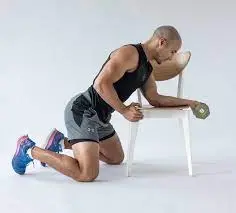
Single Arm Wrist Extension (Dumbbell)
Exercise Instructions:
- A person assumes a seated position with her elbow resting on her knee. To begin the exercise, hold a dumbbell in one hand with the palm and forearm facing down and the wrist flexed. To complete the exercise, slowly extend the wrist and then lower the hand back to the starting position. Alternate arms and take the proper rest between sets.
Parameters:
- Repeat:10-15 x Sets 2
- Weight: lbs
- Frequency: 3 x/wk
Single Arm Forearm Pronation (Dumbbell):
Exercise Instructions:
- A person assumes a seated position with her elbow resting on her knee. Hold a dumbbell in the hand palm up to initiate the exercise. Turn or rotate the forearm down slowly, then rotate it back to finish the repetition. Alter arms and take the proper rest between sets.
Parameters:
- Repeat: 10-15 x Sets 2
- Weight: lbs
- Frequency: 3 x/wk

Single Arm Forearm Supination (Dumbbell):
Exercise Instructions:
- A person assumes a seated position with her elbow resting on her knee. Hold a dumbbell in the hand palm down to initiate the exercise. Turn or rotate the forearm up slowly, then rotate it back to finish the repetition. Alternate arms and take the proper rest between sets.
Parameters:
- Repeat:10-15 x Sets 2
- Weight: lbs
- Frequency: 3 x/wk
Strength-building exercises:
Going to the gym and using equipment like cable machines, light dumbbells, or exercise bands can be helpful in the later stages of rehabilitation. Forearm pain can be prevented from returning by performing strength-building exercises like wrist curls or reverse curls.
SURGERY OR INJECTION:
Exercise is not always enough to relieve pain, and some people may need to take anti-inflammatory drugs. When trapped nerves or other damage are the cause of the discomfort, surgery may be indicated.
Summary:
If a person has a mild sprain or strain, they may be able to manage their condition with home remedies. Rest the forearm and see a doctor if the symptoms get worse instead of improving.
A doctor can diagnose what’s causing the forearm pain. There are many remedies for this condition, and most people can successfully treat their symptoms without surgery.
If a person has sudden or severe arm pain or other symptoms that cause concern, call for emergency medical help. Forearm pain caused by a serious injury or medical emergency can be improved and complications reduced with treatment.
FAQs:
When should I be worried about forearm pain?
A person should be concerned about her forearm pain if they feel like the underlying cause of the pain is a bone fracture, damaged joints, or injured nerves. In the case of a noticeable forearm bone fracture or upon hearing clicking, cracking, or crunching associated with a forearm injury, they should seek immediate medical attention.
How do you relieve forearm pain?
RICE therapy: Rest, ice, compression, and elevation therapy can help relieve pain and inflammation in the affected muscles and tendons of the forearm. Pain medications: Over-the-counter medications may alleviate symptoms of forearm pain.
Is forearm pain normal?
Forearm pain can result from numeral causes. These range from sudden injuries to repetitive strain to underlying medical disorders that damage nerves, bones, or joints. Much of the time, forearm pain is brief and will improve on its own
Can forearm pain be heart-related?
Arm pain, particularly pain that radiates into the left arm, may even indicate a heart attack.
How long can forearm pain last?
Inflammation should go away after two to three weeks of primary care. The forearm is often required to be completely rested for a few days in severe or chronic tendonitis. For several weeks or months, you will also need to avoid activities that irritate the tendon.

